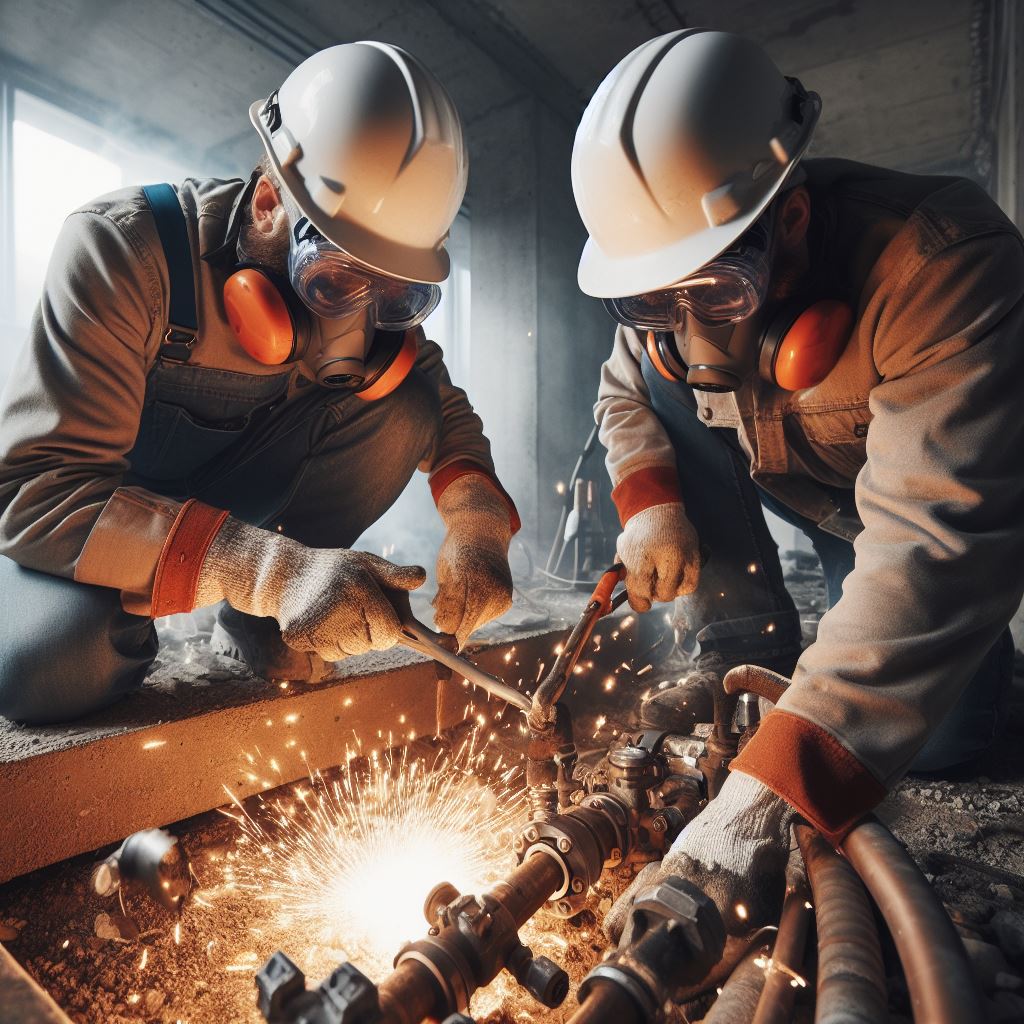Introduction
Plumbing codes are regulations that ensure the proper installation and maintenance of the systems.
Understanding plumbing codes across US states is crucial for compliance and safety reasons.
Plumbing codes are a set of regulations that govern the installation, construction, and maintenance of the system in buildings.
These codes are established by government bodies, such as local municipalities or state authorities, to ensure that the systems meet certain standards of safety, efficiency, and hygiene.
It is essential to understand plumbing codes across US states for several reasons.
Firstly, compliance with these codes is mandatory when constructing or renovating buildings. Failure to comply can result in hefty fines, delays, or even legal consequences.
Therefore, being well-versed in the particular state is crucial for contractors, plumbers, and homeowners.
Secondly, understanding plumbing codes helps ensure the safety and well-being of occupants.
Codes dictate the correct installation of fixtures, such as pipes, valves, and water heaters, to prevent leaks, contamination, or other hazards.
By adhering to these codes, potential risks like water damage, mold growth, or exposure to harmful substances can be significantly reduced.
Moreover, this help maintain the efficiency and longevity of plumbing systems.
They provide guidelines for proper sizing, installation, and maintenance of plumbing components, leading to optimal performance.
By following these codes, professionals can ensure that systems operate efficiently, conserve water, and minimize the need for repairs or replacements.
In short, understanding this is critical for anyone involved in the construction or maintenance of plumbing systems.
By complying with codes, individuals can contribute to the safety, functionality, and longevity of these systems, ultimately benefiting both occupants and the environment.
Overview of Plumbing Codes
Definition of plumbing codes
Plumbing codes are a set of regulations that dictate the design, installation, and maintenance of the systems.
They provide guidelines for ensuring the safety, efficiency, and integrity of plumbing infrastructure.
Purpose of plumbing codes
The primary purpose of this is to protect public health and welfare by preventing unsanitary conditions.
They ensure the proper disposal of wastewater, the distribution of clean water, and the prevention of cross-contamination.
Authority responsible for establishing plumbing codes in each state
In the United States, this are established at the state level rather than by the federal government.
Each state has a designated authority, such as a board or commission, responsible for creating and enforcing these codes.
Transform Your Career Today
Unlock a personalized career strategy that drives real results. Get tailored advice and a roadmap designed just for you.
Start Now1. California
In California, the authority responsible for plumbing codes is the California Building Standards Commission.
They adopt and enforce the California Plumbing Code, which is based on the Uniform Plumbing Code.
2. Texas
The Texas State Board of Plumbing Examiners is the governing authority for plumbing codes in Texas.
They regulate plumbing installations and issue licenses for plumbing professionals.
3. New York
In New York, the Department of Buildings oversees this and regulations.
They enforce the New York City Plumbing Code and ensure compliance with plumbing standards.
4. Florida
The Florida Building Commission is responsible for developing and amending the Florida Plumbing Code.
They ensure the safety and functionality of plumbing systems throughout the state.
5. Illinois
The Plumbing Code Board of Appeals, under the Illinois Department of Public Health, oversees this in Illinois.
They establish regulations and enforce compliance for plumbing installations in the state.
Understanding the intricacies across different US states is essential for professionals and homeowners alike.
By adhering to these codes, we can ensure the proper functioning and safety of our systems, promoting public health and welfare.
It is important to stay updated with any changes or amendments to your respective state to maintain compliance and avoid penalties.
Remember, these are in place to protect us and contribute to the overall well-being of our communities.
Read: Career Pathways: From Apprentice to Master Plumber
Variations in Plumbing Codes
Factors influencing variation in plumbing codes
- Geographical factors: Different terrains and soil conditions may require specific plumbing regulations.
- Climate differences: Extreme weather conditions in certain states can impact plumbing systems.
- Infrastructure variations: Age and condition of existing plumbing infrastructure can affect code requirements.
- Local regulations and codes: Each state and even local municipalities may have their own.
Examples of major differences in plumbing codes across states
Understanding the variations in plumbing codes across US states is essential for professionals and homeowners alike.
Let’s explore some notable examples:
1. Venting Requirements
Some states have strict requirements for the number and placement of vents in plumbing systems, while others are more lenient.
2. Water Heater Installation
Certain states mandate that water heaters be elevated off the ground, while others do not have such regulations.
3. Pipe Materials
States may differ in the types of materials allowed for plumbing pipes, such as copper, PEX, or PVC.
Transform Your Career Today
Unlock a personalized career strategy that drives real results. Get tailored advice and a roadmap designed just for you.
Start Now4. Backflow Prevention
Backflow prevention devices are required in some states to protect against contaminated water, but not in others.
5. Greywater Usage
Rules regarding the usage of greywater (wastewater from sources like sinks and showers) vary across states.
6. Rainwater Harvesting
States differ in their support and regulations for collecting and utilizing rainwater for non-potable purposes.
7. Sewer Connection Requirements
The specifications for connecting plumbing systems to public sewers can vary significantly between states.
8. Water Efficiency Standards
Some states have more stringent requirements for plumbing fixtures to conserve water and promote efficiency.
9. Septic System Regulations
Regulations regarding the installation and maintenance of septic systems can differ greatly among states.
10. Insulation and Freeze Protection
Colder states often have strict rules related to pipe insulation and protection against freezing temperatures.
It’s important for plumbers, contractors, and homeowners to familiarize themselves with these variations to ensure compliance with local plumbing codes.
Failure to adhere to specific requirements can result in fines, delays, or even dangerous plumbing systems.
Consulting with local plumbing authorities and professionals is highly recommended when undertaking plumbing projects in a specific state or region.
Stay tuned for the next chapter, where we delve into the process of navigating plumbing codes in different US states.
Read: Environmental Impact: Green Plumbing Trends in the USA

Key Components of Plumbing Codes
General requirements
- Materials and approved practices should be used in plumbing installations.
- Pipe sizing and capacity must be in accordance with the plumbing codes.
- Fixture requirements, such as the number and type, must be met.
- Ventilation systems should be properly designed and installed.
Specific requirements
- Water supply systems must adhere to this.
- Drainage systems should be designed and installed as per code specifications.
- Gas piping systems must meet the specific requirements.
- Accessibility and safety measures should be implemented in plumbing installations.
Plumbing codes across different US states serve as the backbone for safe and efficient practices.
These codes outline the guidelines, standards, and regulations that govern installations in residential, commercial, and industrial buildings.
Understanding the key components of plumbing codes is essential for plumbers, contractors, and building owners to ensure compliance and avoid potential issues.
General requirements
The general requirements section of plumbing codes focuses on the fundamental aspects that should be followed in plumbing installations.
These requirements encompass the materials, practices, sizing, and ventilation systems.
Materials and approved practices
Plumbing codes specify the types of materials that must be used for different components such as pipes, fittings, and fixtures.
These materials should meet certain standards and be approved by regulatory bodies.
Additionally, plumbing codes dictate the approved practices for joining pipes and installing fixtures.
Transform Your Career Today
Unlock a personalized career strategy that drives real results. Get tailored advice and a roadmap designed just for you.
Start NowPipe sizing and capacity
Plumbing codes provide guidelines for determining the appropriate size of pipes based on the anticipated water demand and pressure.
It ensures that the plumbing system can handle the required flow rate and maintain adequate pressure.
Proper sizing prevents issues like low water pressure or pipe bursts.
Fixture requirements
Plumbing codes define the number and type of fixtures that can be installed in a building based on its occupancy.
This includes toilets, sinks, showers, bathtubs, and other plumbing fixtures.
The codes ensure that there are adequate fixtures available to accommodate the building occupants while maintaining sanitation and hygiene.
Ventilation systems
Proper ventilation is crucial in plumbing installations to prevent the buildup of harmful gases, such as sewer gases and carbon monoxide.
Plumbing codes specify the design and installation requirements for ventilation systems, including the size of vents and their location relative to fixtures.
Specific requirements
In addition to the general requirements, plumbing codes also include specific provisions for different aspects of the systems that need precise attention.
Water supply systems
Plumbing codes outline the regulations for water supply systems, including the design, installation, and maintenance of water lines.
These codes ensure the delivery of clean and safe water and prevent contamination or cross-connections.
Drainage systems
Plumbing codes specify the requirements for drainage systems to ensure the proper removal of wastewater and prevent sewer backups or leaks.
This includes grading, pipe slope, and the use of traps and cleanouts.
Gas piping systems
For buildings that utilize gas for heating, cooking, or other purposes, plumbing codes provide specific guidelines for the design and installation of gas piping systems.
This ensures the safe flow and containment of gas within the premises.
Accessibility and safety measures
Plumbing codes emphasize the importance of accessibility and safety in plumbing installations.
These include provisions for accessible plumbing fixtures, such as grab bars and lever-operated handles, to accommodate individuals with disabilities.
Additionally, safety measures, such as backflow prevention devices and pressure relief valves, are also required to protect the plumbing system and its users.
Complying with plumbing codes is essential to uphold public health, safety, and welfare.
Transform Your Career Today
Unlock a personalized career strategy that drives real results. Get tailored advice and a roadmap designed just for you.
Start NowProfessionals must stay up to date with the codes in their respective states to ensure they are implementing best practices and providing reliable services.
Building owners and contractors must also familiarize themselves with the plumbing codes to avoid costly mistakes and ensure the longevity and efficiency of their systems.
Read: Safety Protocols and Standards for US Plumbers
Challenges and Benefits of Adhering to Plumbing Codes
Challenges faced by plumbers and contractors
- Keeping up with evolving codes
- Understanding and implementing different codes for projects in different states
Plumbers and contractors often face challenges when it comes to adhering to plumbing codes. One of the major challenges is keeping up with the evolving codes.
Plumbing codes are regularly updated and revised to ensure the safety and efficiency of the systems.
Plumbers and contractors need to stay updated with the latest changes to avoid any violations and ensure that their projects meet the required standards.
Another challenge faced by plumbers and contractors is understanding and implementing different codes for projects in different states.
It can vary from one state to another, and sometimes even within different municipalities within the same state.
This means that plumbers and contractors working on projects in multiple states need to be familiar with and comply with different sets of codes.
This adds complexity and requires them to constantly reference and understand the variations in codes to avoid non-compliance.
Benefits of adhering to plumbing codes
- Ensuring safety and public health
- Preventing costly repairs and system failures
- Meeting legal and insurance requirements
While complying with plumbing codes can be challenging, there are several benefits that come with adhering to these regulations.
One of the primary benefits is ensuring the safety and public health of the building occupants.
Plumbing codes are designed to set minimum standards for the installation and maintenance systems, which helps prevent potential hazards such as contamination and waterborne diseases.
Adhering also helps prevent costly repairs and system failures in the long run.
By following the guidelines and requirements outlined, plumbers and contractors can ensure that the systems they install are reliable and less prone to breakdowns.
This can help homeowners and building owners save money on repairs and maintenance expenses in the future.
In addition to safety and cost savings, adherence is crucial for meeting legal and insurance requirements.
Non-compliance can result in legal penalties and liabilities. It can also lead to insurance claims being denied in the event of any plumbing-related incidents.
Therefore, by following the codes, plumbers and contractors not only fulfill their legal obligations but also maintain adequate insurance coverage for their projects.
In essence. while there are challenges in keeping up with evolving and implementing different codes for projects in different states, the benefits of adhering to outweigh the difficulties.
Transform Your Career Today
Unlock a personalized career strategy that drives real results. Get tailored advice and a roadmap designed just for you.
Start NowCompliance ensures safety, prevents costly repairs, and helps meet legal and insurance requirements, all of which are essential for the successful completion of plumbing projects.
Read: Veterans Transitioning into Welding Careers in the United States
Resources for Understanding and Complying with Plumbing Codes
Government agencies and organizations responsible for plumbing codes
- United States Department of Housing and Urban Development (HUD)
- National Fire Protection Association (NFPA)
- American Society of Plumbing Engineers (ASPE)
- International Association of Plumbing and Mechanical Officials (IAPMO)
- State and local building departments
Websites, manuals, and publications for plumbing code references
- The International Plumbing Code (IPC)
- The Uniform Plumbing Code (UPC)
- The National Plumbing Code of Canada
- Plumbing codes specific to each state and municipality
- Plumbing trade magazines and journals
- Online resources such as Plumbing-Code.org
Importance of consulting with local authorities and experts
Understanding and complying with this can be a complex task due to the variations between states and municipalities.
It is crucial to consult with local authorities and plumbing experts to ensure compliance with specific regulations.
The following reasons highlight the importance of seeking reliable resources:
Legal compliance
Plumbing codes are legal requirements, and violating them can result in penalties, fines, or legal consequences.
Consulting with local authorities ensures adherence to the applicable codes and prevents legal troubles.
Safety and health considerations
This aim is to ensure the safety of residents and the general public.
Compliance with these codes helps maintain proper sanitation, prevent water contamination, and minimize the risk of accidents.
Efficient construction and maintenance
Following plumbing codes streamline the construction and maintenance processes.
Regulations prevent common issues, such as pipe leakage, improper drainage, or insufficient venting.
Adhering to efficient systems.
Quality standards
Plumbing codes establish minimum standards for materials, installation methods, and system design.
By consulting with experts and reliable resources, one can ensure the use of quality materials and latest techniques.
Avoidance of costly mistakes
Non-compliance with plumbing codes can lead to costly rework or repairs.
Accessing accurate code references and consulting with professionals reduces the likelihood of errors, saving both time and money.
Awareness of updates and changes
Plumbing codes are subject to periodic updates and changes.
Staying updated through reliable resources helps avoid using outdated codes and ensures compliance with the latest regulations.
Mitigation of liability risks
Proper compliance with plumbing codes reduces liability risks for property owners, contractors, and plumbers.
It provides assurance that the plumbing system meets safety standards and minimizes the potential for accidents or damage claims.
Transform Your Career Today
Unlock a personalized career strategy that drives real results. Get tailored advice and a roadmap designed just for you.
Start NowPlumbing codes play a fundamental role in ensuring the safety, functionality, and integrity of plumbing systems.
Recognizing their importance and utilizing appropriate resources is crucial for anyone involved in plumbing design, construction, or maintenance.
By consulting with government agencies, referring to code manuals, and seeking expert advice, individuals can navigate the intricacies of plumbing effectively and ensure compliance with applicable regulations.
Conclusion
Understanding plumbing codes across US states is highly significant for various reasons.
Following plumbing codes is crucial for the success of any plumbing project.
I encourage readers to consistently stay informed and updated on plumbing codes.
Significance of Understanding Plumbing:
Grasp the importance of comprehending plumbing codes, a critical factor in ensuring successful projects across diverse US states.
Importance of Following Plumbing:
- Ensuring Compliance: Adhering to codes guarantees compliance with state regulations, laying the foundation for a successful and legal plumbing project.
- Safety and Quality: Following codes promotes safety and ensures the delivery of high-quality plumbing work, meeting industry standards.
Encouragement to Stay Informed:
- Continuous Learning: Stay informed and updated on plumbing, empowering yourself with knowledge for efficient and effective project execution.
- Professional Growth: Embrace the opportunity for professional growth by actively staying informed on evolving plumbing in different US states.
[E-Books for Sale]
The Big Book of 500 High-Paying Jobs in America: Unlock Your Earning Potential
$19.99 • 500 High-Paying Jobs • 330 pages
Explore 500 high-paying jobs in America and learn how to boost your career, earn more, and achieve success!
See All 500 High-Paying Jobs of this E-Book
1001 Professions Without a Degree: High-Paying American Jobs You Can Start Now
$19.99 • 1001 Professions Without a Degree • 174 pages
Discover 1001 high-paying jobs without a degree! Unlock career tips, skills, and success strategies for just $19.99!




